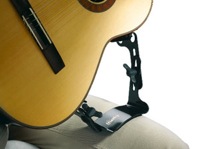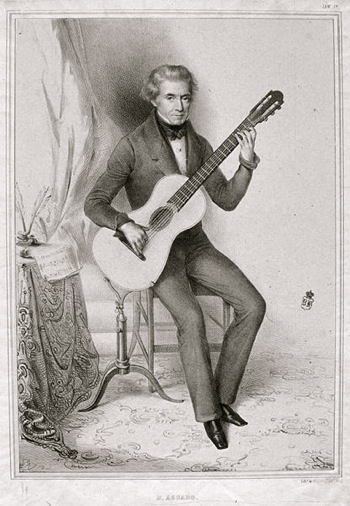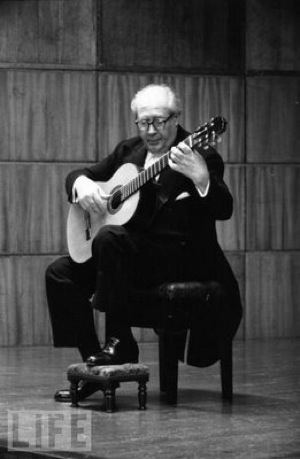How to Hold a Classical Guitar
The first guitar technique you need to learn is how to hold a classical guitar. If have in a good classical guitar sitting position, then playing will feel relaxing and effortless.
Step 1: Sit Properly

First, sit down on a chair without holding your guitar. The chair shouldn't be too high or two low - it should be just the right height so that your knees form roughly a 90 degree angle.
Then, put both feet flat on the ground, about hips-width distance apart.
Straighten your spine, neck, and head, so that your whole upper body is balanced as effortlessly as possible.
Step 2: Place the Guitar
Once you are sitting properly, place the guitar in the correct playing position with whichever classical guitar support you decide to use. The goal is to place the guitar so that both hands will have easy access to the strings.
With a Foot Stool:

If you are using a footstool, place the footstool underneath your left foot, raised up 3 - 4 notches. Then place the guitar so that the the middle of the body rests on your left thigh, and the lower bout (lower part of the body) rests on your right thigh. You can move you right foot slightly outward to make more room for the body.
With an Attachable Support:

If you are using an attachable support, attach the support on the side of the guitar (each support should come with specific instructions), then place the support/guitar on your left leg. The lower bout should rest on your right leg.
With a Strap:

If you are using a strap, attach the strap to both ends of the guitar - the right side over the peg, and the left side tied to the head. Then slip your right arm and your head through the strap, so that strap rests across your back and over your left shoulder. The lower bout should rest on your right thigh. Adjust the strap so that the guitar is not too loose.
General Guidelines for Placing the Guitar
The guitar neck should be to the left side. Also, the guitar neck should be at less than a 45 degree angle. To check this, make sure the head of the guitar does not go above your eye level.
Regardless of which support you use, the guitar should be centered across your body. When you look down, your nose should be somewhere between the 12th fret and the soundhole of the guitar.
The guitar should be in the middle of your torso - not too high or too low. The top of the guitar should be around chest level. If you are wearing button shirt, chest level is about 3 - 4 buttons down from the top.
Also, the guitar should be able to stay in place without your arms and hands touching it. If it isn't staying in place, consider buying rubber grippers to place on your thighs.
Step 3: Place Your Arms on the Guitar

Pick up your right arm and balance it on the lower bout of the guitar. Your lower arm (the part near your elbow) should be touching the edge of the guitar. Your arm should feel perfectly balanced, so that you don't need to actively hold it in place. Your hand should hang over the bottom of the sound hole (see picture below).
Pick up your left arm and place it around the middle of the neck. Your elbow should be relaxed and hang naturally below your hand. Your thumb should lightly rest behind the neck, while your fingers lightly rest on the fretboard.
Both arms should extend an equal distance from your body. For instance, you shouldn't feel like you need to reach far with your left arm, while your right arm is next to your body.
Both wrists should be relatively straight and relaxed. However, the right hand can arch slightly to reach the strings.
Also, make sure you keep your shoulders relaxed.
If you have problems placing your arms comfortably on the guitar, go back to step 2 to adjust the guitar to a better position.
Classical Guitar Posture Checklist
Check these things to make sure you did everything correctly in Steps 1 through 3.
- Sit up straight
- Knees at 90 degree angle, feet flat on ground
- Shoulders Relaxed
- Guitar centered across body (your nose is over the 12th fret)
- Guitar in middle of torso (upper bout touches your chest)
- Guitar neck is 45 degrees or less (head is below eye level)
- Guitar holds in this position without arms touching it.
- Right arm balanced on lower bout
- Both arms extended equally from the body.
- Both wrists relatively straight and relaxed
Examples of Good Playing Positions
Aguado Holding the Guitar
This picture of Dionisio Aguado, a famous 19th century guitarist, is a good example of how to hold a classical guitar. He is using a tripod (one of his own inventions) to hold the guitar in place, but you can get the guitar in this position with any classical guitar support.

Segovia Holding the Guitar
Here is a fantastic picture of Andrés Segovia, one of the most famous classical guitarists of all time, holding his guitar. Notice how relaxed and comfortable he looks with his foot stool.

Copyright 2014 © ClassicalGuitar101.org | All Rights Reserved
Popular Articles:
Making a Living as a classical guitarist
List of Classical Guitar Competitions
About Me
My name is Daniel Nelson, and I am a classical guitar teacher and performer from Los Angeles, California. Click here to learn more.
Leave a Comment!